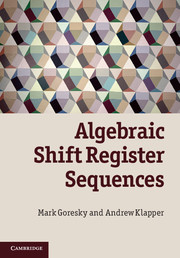Book contents
- Frontmatter
- Contents
- List of figures
- List of tables
- Acknowledgements
- 1 Introduction
- PART I ALGEBRAICALLY DEFINED SEQUENCES
- 2 Sequences
- 3 Linear feedback shift registers and linear recurrences
- 4 Feedback with carry shift registers and multiply with carry sequences
- 5 Algebraic feedback shift registers
- 6 d-FCSRs
- 7 Galois mode, linear registers, and related circuits
- PART II PSEUDO-RANDOM AND PSEUDO-NOISE SEQUENCES
- PART III REGISTER SYNTHESIS AND SECURITY MEASURES
- PART IV ALGEBRAIC BACKGROUND
- Bibliography
- Index
3 - Linear feedback shift registers and linear recurrences
from PART I - ALGEBRAICALLY DEFINED SEQUENCES
Published online by Cambridge University Press: 05 February 2012
- Frontmatter
- Contents
- List of figures
- List of tables
- Acknowledgements
- 1 Introduction
- PART I ALGEBRAICALLY DEFINED SEQUENCES
- 2 Sequences
- 3 Linear feedback shift registers and linear recurrences
- 4 Feedback with carry shift registers and multiply with carry sequences
- 5 Algebraic feedback shift registers
- 6 d-FCSRs
- 7 Galois mode, linear registers, and related circuits
- PART II PSEUDO-RANDOM AND PSEUDO-NOISE SEQUENCES
- PART III REGISTER SYNTHESIS AND SECURITY MEASURES
- PART IV ALGEBRAIC BACKGROUND
- Bibliography
- Index
Summary
Besides being interesting fundamental mathematical objects in their own right, linearly recurrent sequences have proved to be useful in many applications, including pseudo-random number generation, error correcting codes, private key cryptosystems, radar ranging, code division multiple access communications, and many other areas. They provide a fast and simple method of generating statistically random sequences. Moreover, many of their properties can be analyzed using various algebraic structures. The primary algebraic tools used to analyze linearly recurrent sequences are polynomials, power series, and trace functions on finite fields. The results in this section are all classical, many of them having been known for over 100 years. However we have organized this section in a slightly unusual way (from the modern perspective) in order to better illustrate how they are parallel to the FCSR and AFSR theory which will be described in later chapters.
There are many ways to describe the output sequence of an LFSR, each of which has its merits. In this chapter we discuss the matrix presentation (Section 3.2), the generating function presentation (Theorem 3.5.1), the algebraic presentation (Proposition 3.7.1), the trace representation (Theorem 3.7.4), and the sums of powers representation (Theorem 3.7.8).
Definitions
In this section we give the definitions and describe the basic properties of linear feedback shift registers and linearly recurrent sequences. Throughout this chapter we assume that R is a commutative ring (with identity denoted by 1).
- Type
- Chapter
- Information
- Algebraic Shift Register Sequences , pp. 23 - 68Publisher: Cambridge University PressPrint publication year: 2012



